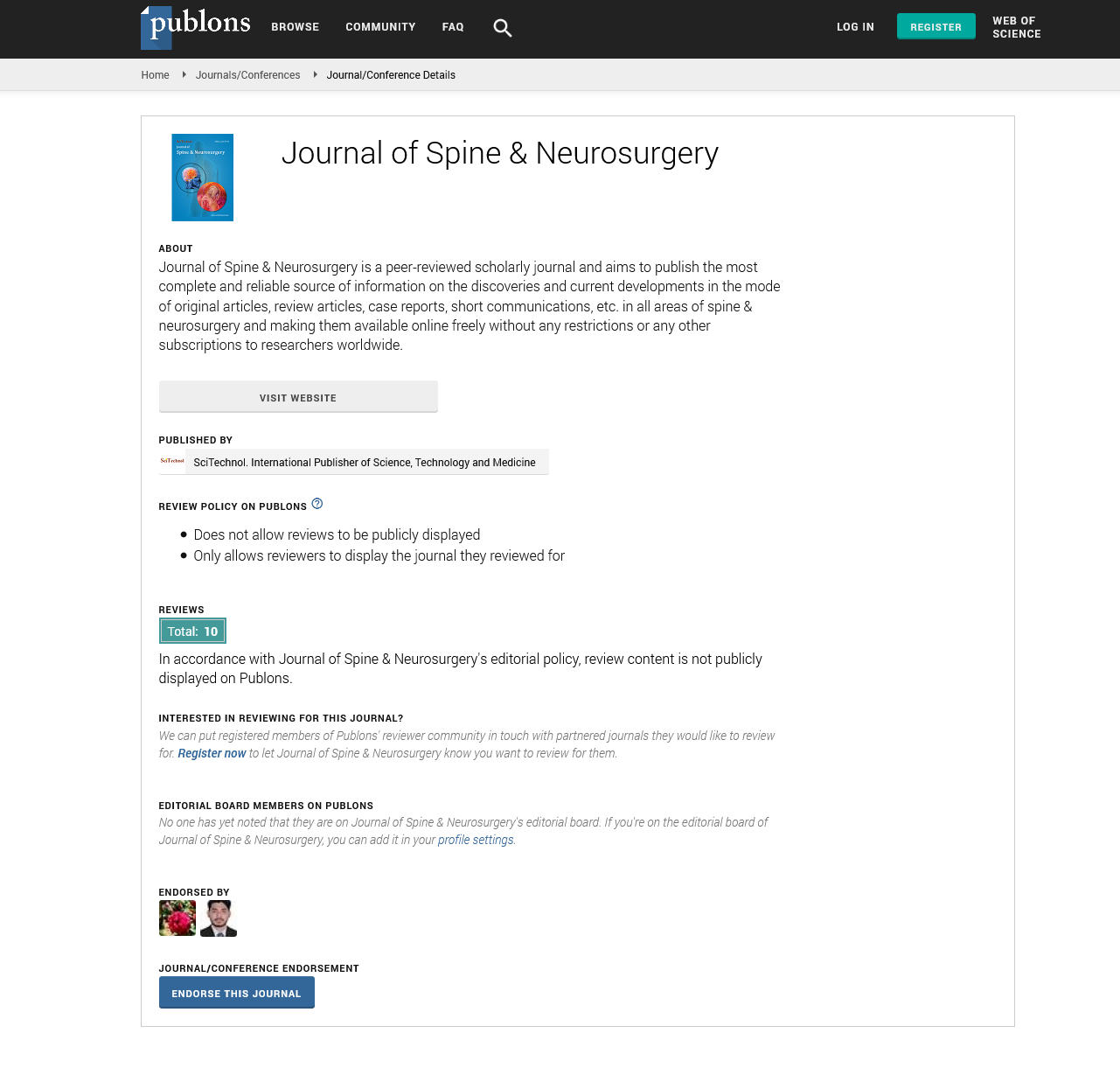Perspective, J Spine Neurosurg Vol: 13 Issue: 4
Emerging Strategies in Spinal Intervention: Insights into Techniques, Indications, and Recovery Outcomes
Steven Alexey*
1Department of Kinesiology and Health Sciences, University of Ontario, Ontario, Canada
*Corresponding Author: Steven Alexey,
Department of Kinesiology and Health
Sciences, University of Ontario, Ontario, Canada
E-mail: steven.alexey@gmail.com
Received date: 27 July, 2024 Manuscript No. JSNS-24-152426;
Editor assigned date: 30 July, 2024, PreQC No. JSNS-24-152426 (PQ);
Reviewed date: 12 August, 2024, QC No. JSNS-24-152426;
Revised date: 19 August, 2024, Manuscript No. JSNS-24-15242 6 (R);
Published date: 29 August, 2024, DOI: 10 .4172/2327-4581.1000219.
Citation: Alexey S (2024) Emerging Strategies in Spinal Intervention: Insights into Techniques, Indications and Recovery Outcomes. J Spine Neurosurg 13:2.
Description
Spinal interventions have seen remarkable advancements in recent years driven by innovations in medical technology surgical techniques and a deeper understanding of spinal pathologies. As the population ages and spinal disorders become more prevalent there has been an increasing need for effective and minimally invasive strategies for treating a wide range of spinal conditions. From degenerative diseases and herniated discs to spinal deformities and trauma emerging strategies in spinal intervention are offering new hope for patients seeking relief from pain and a return to normal function.
One of the most promising areas of development in spinal intervention is the shift towards minimally invasive techniques. Traditional open surgeries for spinal conditions often require large incisions extended recovery times and increased risk of complications. However Minimally Invasive Spine Surgery (MISS) is revolutionizing the field by enabling surgeons to perform complex procedures with smaller incisions resulting in less tissue disruption and faster recovery times. Technologies such as endoscopic cameras robotic-assisted surgery and laser tools allow for greater precision and reduced trauma to surrounding tissues. These methods not only enhance surgical outcomes but also help to alleviate the postoperative pain and long hospital stays that were once commonplace.
Another important advancement in spinal intervention is the growing use of spinal injections to manage pain and inflammation. For many patients particularly those with chronic back pain spinal injections provide a non-surgical treatment option. Epidural steroid injections for instance are commonly used to reduce inflammation around nerve roots and help alleviate symptoms associated with conditions like sciatica or spinal stenosis. These injections are typically performed under fluoroscopic guidance ensuring accuracy and minimizing the risk of complications. Additionally newer techniques such as platelet-rich plasma injections and stem cell therapies are gaining attention for their potential to accelerate healing and reduce the need for more invasive procedures.
Spinal fusion has long been a cornerstone in the treatment of conditions such as spinal instability scoliosis and degenerative disc disease. While spinal fusion is effective in stabilizing the spine it often comes with the drawback of limiting flexibility at the fused segment and potentially accelerating wear and tear on adjacent vertebrae. However emerging techniques like artificial disc replacement and dynamic stabilization offer alternative solutions. ADR for example aims to preserve motion by replacing a damaged disc with an artificial one that mimics the natural movement of the spine. This technology has been shown to reduce the loss of mobility that comes with traditional spinal fusion while also providing relief from pain.
Advancements in imaging technology have also plays an essential role in the evolution of spinal interventions. High-resolution imaging such as 3D computed tomography scan scans and Magnetic Resonance Imaging (MRI) provide detailed views of the spine allowing for more accurate diagnoses and better treatment planning. With these improved imaging techniques surgeons can identify subtle abnormalities and plan surgeries with greater precision. Additionally real-time imaging used in procedures like spinal injections or minimally invasive surgeries allows for better visualization of structures and ensures that interventions are performed safely and accurately.
The indications for spinal interventions have expanded significantly in recent years as a result of these technological advancements. Conditions that once required invasive open surgeries can now often be treated with less invasive methods. For example spinal stenosis a condition where the spinal canal narrows and puts pressure on the spinal cord or nerves can often be treated with minimally invasive decompression techniques. These procedures remove the pressure from the nerves and allow for a quicker recovery. Similarly herniated discs that press on surrounding nerves can be treated through microdiscectomy or laser procedures that require only small incisions and result in less postoperative pain.
Recovery outcomes for spinal interventions have improved as a result of these innovations. Patients who undergo minimally invasive spine surgery generally experience less pain and a faster return to daily activities compared to traditional open surgeries. Recovery times for spinal fusion surgeries have also been shortened due to improved surgical techniques and more advanced post-operative care protocols. Furthermore patients who undergo non-surgical treatments like spinal injections or physical therapy often report significant improvements in pain and function without the need for more invasive procedures.
Conclusion
As the field of spinal intervention continues to evolve emerging strategies are providing patients with more options for treating spinal conditions with better outcomes and fewer risks. Whether through minimally invasive surgeries advanced spinal injections or newer technologies like artificial disc replacement and stem cell therapies the future of spinal care is brighter than ever. These advancements offer patients hope for faster recovery times less pain and a better quality of life. As research and technology continue to advance it is likely that even more effective and targeted treatments will emerge further transforming the landscape of spinal care.
 Spanish
Spanish  Chinese
Chinese  Russian
Russian  German
German  French
French  Japanese
Japanese  Portuguese
Portuguese  Hindi
Hindi 
